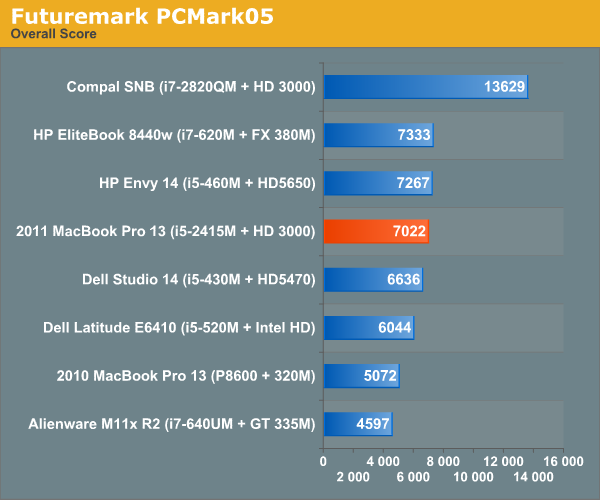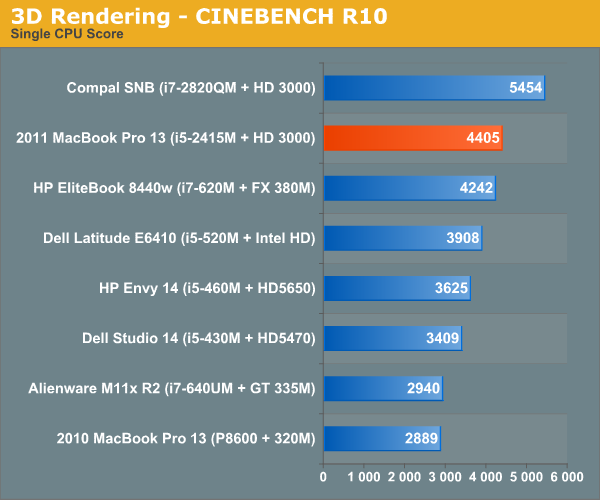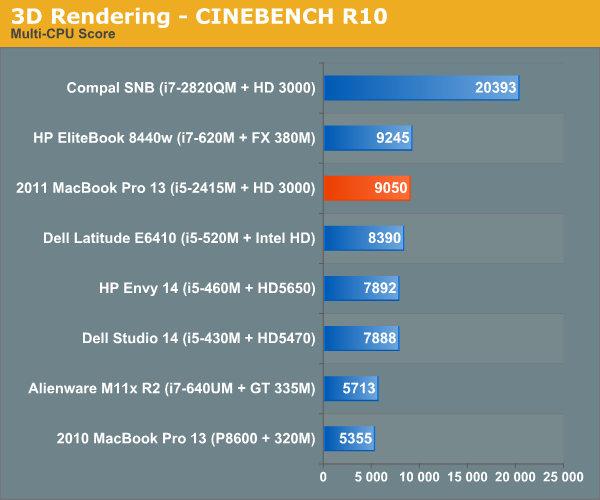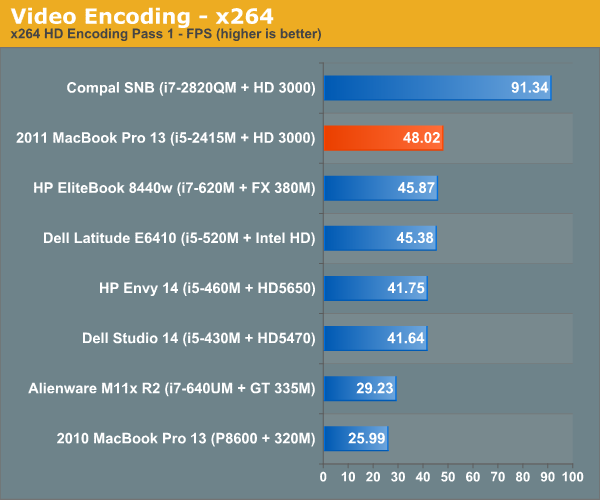The MacBook Pro Review (13 & 15-inch): 2011 Brings Sandy Bridge
by Anand Lal Shimpi, Brian Klug & Vivek Gowri on March 10, 2011 4:17 PM EST- Posted in
- Laptops
- Mac
- Apple
- Intel
- MacBook Pro
- Sandy Bridge
Application Performance in Windows
by Vivek Gowri
In keeping with recent tradition, I'm in charge of evaluating the new MBP under our Windows notebook benchmark suite. Mostly, the MBP works very well as a PC, something I looked at last year with the old 13-inch MacBook Pro. I have the new base 13 in the labs, and I must say, the overall experience is pretty similar...unless you're gaming. But I'll get to that in a minute.
Unlike on the Air I was testing last time around, the Windows install went pretty smoothly thanks to the built-in optical drive. Unfortunately, that's probably going to be the last time I ever use it. And also unlike the Air, there's no problems with storage space here—with the 320GB drive included in the base 13, you have more than enough space for two moderately-sized OS install partitions.
With Windows and Boot Camp drivers out of the way, I fired up our notebook benchmark suite. The new MBP is the first dual core Sandy Bridge notebook we've had in our labs, so I was pretty interested in seeing the performance relative to Arrandale, as well as the old Core 2 Duo-based MBP13. According to CPU-Z, the base spec 13 that I have has the i5-2415M inside, a dual core processor with HyperThreading and clocked at 2.3GHz with max turbo frequency of 2.9GHz. The 2415M is an interesting chip, closely related to the i5-2410M. It's so interesting that Intel doesn't even have a product page for it, which made me curious as to what the difference between the two is. Turns out, the 2415M is the same chip as the 2410M, just in a smaller package. The normal mobile Core i5/i7 processors have a 37.5 x 37.5mm PPGA (plastic pin grid array) package, meant for Socket G2 (also known as rPGA 988B).
The 2415M, on the other hand, has a package size of 31 x 24mm with a micro-FCBGA mounting method. It's the same package size and mounting as the low voltage and ultra-low voltage Sandy Bridge processors, using the same BGA 1023 socket. Apple probably chose the 2415M to make packaging around the processor easier. Smaller is always better in the Apple world.
The other interesting wrinkle here is that Apple has forgone a separate graphics chip for the first time in a very long while. This is the first Apple with Intel graphics since the MacBook's January 2009 refresh brought Nvidia 9400M graphics, and the first MacBook Pro with Intel graphics. Ever.
What does all of this mean for performance? Let's take a look. If you're comparing to the old Core 2 Duo based MBP13, CPU-based performance is almost two times faster across the board. Given the huge jump in power between Core 2 and the further two generations of Core processors, this makes a lot of sense. It was seriously about time that Apple moved on from Core 2 in its smaller notebooks, and this huge performance jump is a direct result. We'll see what happens with the regular MacBook and MacBook Air, but I'd expect a similarly large increase in performance in those models when they're next updated as well.






Looking at the Arrandale-based Core i5-430M, which at 2.26GHz is a logical point of comparison to the i5-2415, we see that performance has improved 15-20%.
This doesn't look as impressive as the gains in performance we saw with our first look at the mobile SNB quad-cores, but Sandy Bridge quads are clocked a lot higher than the preceding Clarksfield chips. Our quad-core SNB mobile testbed had an i7-2820QM, with a 2.3GHz core clock and max turbo frequency of 3.4GHz. The 2820QM replaces the 1.86GHz i7-840QM, so the clock speed is 24% higher. Factor that in, and the increase is more in line with what we saw from the dual-cores.
The big deal here is that now, the lowest end SNB i5 performs roughly on par with the top end Arrandale i7 dual cores. Like Anand said in his Sandy Bridge review, you get yesterday's top of the line performance for a much lower price.










198 Comments
View All Comments
claytontullos - Friday, March 11, 2011 - link
The laptop was not constantly crashing, maybe 1-2 times per week. Had I sent it in to them nothing would have happened because they would have run their own woefully inadequate ram test. I replaced the ram and have not had any crashes since.HP also insisted that I reinstall vista when my led screen turned solid blue at a certain angle.
alent1234 - Friday, March 11, 2011 - link
i've been dealing with computers long enough to remember lifetime warranties being standard and dell sending replacement parts with no questions asked.around 2000 is when it changed and i've had to lie to tech support even when i called for large customers with tens of thousands of dell computers bought.
my own personal experience with HP tech support for a work laptop vowed me to never buy a HP laptop again unless it's from costco or dirt cheap to where i can buy one every year and junk it without thinking twice.
same with dell. 7 years ago i bought a $1500 laptop with the 3 year warranty. 2 years into it i find out the battery is not covered. Unlike with Apple where the entire laptop is covered and going to the genius bar doesn't mean being on hold for hours and needing a translator to talk to someone
erple2 - Friday, March 11, 2011 - link
Huh. I've never had a problem with HP service before. I've had HP laptops ranging from the 2800T to an Elitebook 6930p to an Envy 15. In each case, there was an issue that had to be resolved, and I received prompt, accurate service, including a box they sent to me to ship the device back to them. Yes, they didn't cross ship a laptop, but that's not practical.My experience with Apple's Genius Bar, however, hasn't been so rosy. Personally, I'd rather wait on hold in my house for 2 hours than wait around at a Genius Bar for 2 hours for someone to actually help you. Granted, it was crowded, but it's irrelevant to this discussion.
claytontullos - Saturday, March 12, 2011 - link
When the problem and solution is crystal clear to even the most ignorant person then HP's service is fantastic: ie: Won't Power On, Disc wont eject, Nothing on screen.However with intermittent issues HP's support is horrible. Even speaking with a supervisor nets little reprieve from ignorance.
argosreality - Thursday, March 10, 2011 - link
The Envy line comes with its own dedicated support group that is not the usual, outsourced to India group. Quite a bit better. Also, strangely I have seen memory pass the Pc-doctor tests (usually what HP uses outside of the BIOS runs) but fail memtest. Not sure why, could just be different test algorithemsstarfalcon - Sunday, May 15, 2011 - link
What kind of 13 inch laptops have discrete graphics anyway?Except maybe that smaller Alienware.
Taft12 - Thursday, March 10, 2011 - link
<i>My preference would be two cables: one for power and one for peripherals/display. Today, it's five.</i>What you've just said is that Macbooks need a Dell Latitude-style docking station option in the worst possible way. Your preference is 2 cables. Mine is zero. Just snap in. (I've had this for over a decade now)
If Apple is serious about phasing out desktops as you suspect, that'll be something that needs to come first.
secretmanofagent - Thursday, March 10, 2011 - link
I've always been hesitant of docking stations. I've had a Dell that for the most part would undock somewhat correctly, and currently have an HP work computer that refuses to undock at all. For me, the convenience has always been hampered by the usability.gstrickler - Thursday, March 10, 2011 - link
Actually, with MagSafe power and Thunderbolt, that's essentially possible. A dock that includes a connection to both ports could offer Mini-DisplayPort, DVI, VGA, USB, Ethernet, FireWire, eSATA, and Thunderbolt connections, and optionally, even a PCI slot or two. With 4x PCIe compatibility and 20Gb/s bidirectional throughput, a Thunderbolt port has plenty of bandwidth for that. Of course, Apple is currently the only company who could offer it with the MagSafe connection, but a third party could at least reduce it to 2 quick connections.erple2 - Friday, March 11, 2011 - link
Huh. My windows laptop has only 1 connection that handles mouse, keyboard, monitor, power, ethernet and external storage. 'Course that's the beauty and convenience of a (working) docking station, something that I never really thought was worthwhile until I actually got one.I'm bummed that consumer products don't come with one.